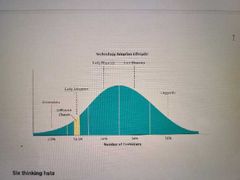![]()
![]()
![]()
Use LEFT and RIGHT arrow keys to navigate between flashcards;
Use UP and DOWN arrow keys to flip the card;
H to show hint;
A reads text to speech;
23 Cards in this Set
- Front
- Back
|
Angel investor |
Someone who has available funds and interest in supporting a new venture |
|
|
Venture capitalist (VC) |
A group of people or organizations who pool resources to invest in entrepreneurial ventures, contributing larger sums of fund then are available through angel investors |
|
|
Intellectual property |
The output or result if the creative work of one or more individuals to turn a unique idea into a practice and value added P/S |
|
|
Types of intellectual property |
Utility patent, design patent, copyright, trademark, and trade secret |
|
|
Everett Roger's |
American theorist and sociologist who created Rodgers adoption curve |
|
|
Rodgers adoption curve |

|
|
|
Six thinking hats |
A brainstorming method that frees you from considering other aspects of the problem that can limit creativity when you are looking for a solution. That hat's are: White- research Red- emotions Black- logic /devils advocate Yellow- Encouragement, problem solving Green- creativity, new ideas Blue- mediator |
|
|
Empathy driving product development |
Human centric design thinking exercise with 5 parts, 1. Accessing and expressing empathy 2. Definitely the problem 3. Ideation solutions 4. Prototyping 5. Testing Then repeat |
|
|
Drucker 7 sources if innovation |
1. The unexpected- ex. Product performance 2. Incongruity- the difference between what should be and what is 3. Process need- weaknesses 4. Change in industry 5. Demographics- needs and wants 6. Change in perception 7. New knowledge |
|
|
David Pridham of Dominion Harbor Group |
There are 6 reasons why current conditions are excellent for startups 1. Highest VC ever 2. Better intellectual property rights and protection 3. Artificial intelligence market 4. Huge market of freelance workers 5. Technological advancement like self driving cars 6. IP amounts for 38% of GDP, highest in the world except China |
|
|
Kill zone |
Markets that tech giants like Facebook and Amazon control through aggressive anticompetitive tactics |
|
|
Feasibility |
The state or degree of being easily or conveniently done |
|
|
Creative destruction |
Coined by Joseph Schumpeter, "process of industrial mutation that incessantly revolutionizes the economic structure from within, incessantly destroying the old one, incessantly creating a new one" |
|
|
Gig economy |
Using temporary and often transitional positions hired on a case by case basis rather then keeping a full Staff of hired employees. Good for workers because flexibility, good for employers because less costly |
|
|
Storyboarding |
The process of presenting an idea in a step by step graphic format |
|
|
Creative problem solving process |
1. Clarify- recognize the gap 2. Ideate- brainstorm 3. Develop- review ideas for feasibility 4. Implement- solution is tested and evaluated 5. Evaluate- final solution is assessed |
|
|
SMART goal |
Helps one realized the steps needed to make that vision a reality Specific- precise Measurable Achievable- attainable Relevant Timely |
|
|
Crowdsourcing |
Involves teams of amateurs and nonexperts working together to form a solution to a problem |
|
|
Entrepreneurial journey |
Self discovery, exploration, experiences, and accomplishments. Every journey is different |
|
|
Business Cycle |
Startup, launch, growth, maturity, harvest, rebirth/exit |
|
|
Corporate entrepreneur |
When large corporations fund the development of new ideas, opportunities, or ventures through formal research and development processes thay focus on the corporations own strategy and goals |
|
|
Musk decision making process |
1. Ask a question 2. Gather evidence 3. Develop axioms 4. Draw conclusion 5. Test conclusion 6. Validate conclusion |
|
|
Scientific method |
1. Make an observation 2. Ask a question 3. Form a hypotheses 4. Make a prediction 5. Do an experiment 6. Analyze results |

